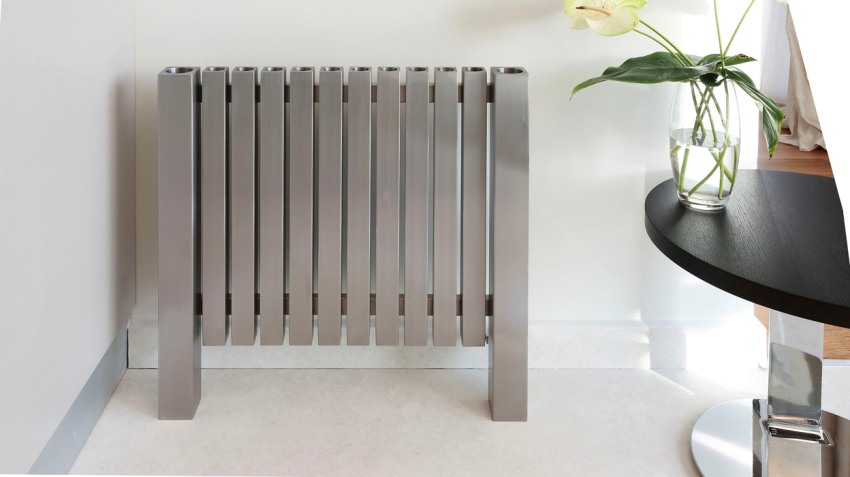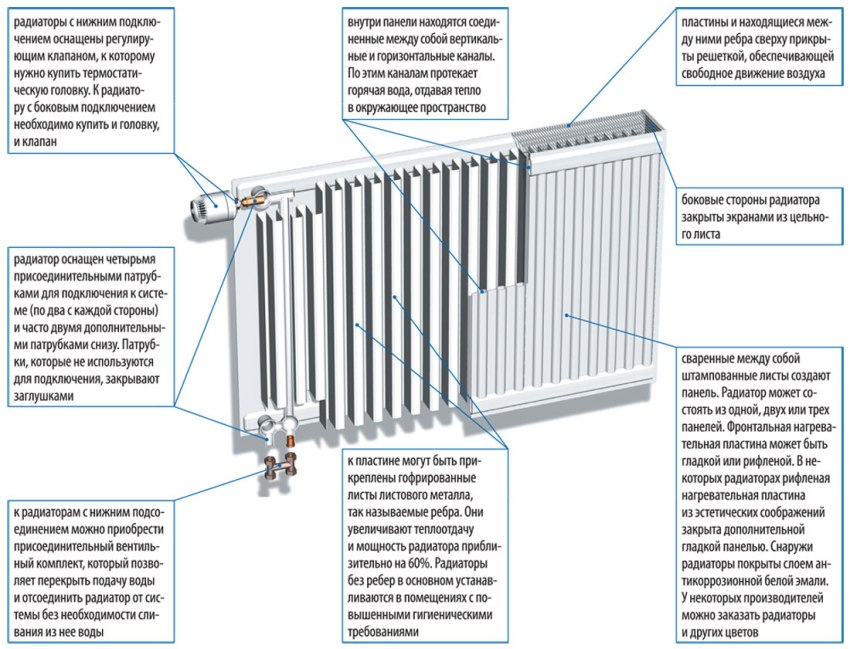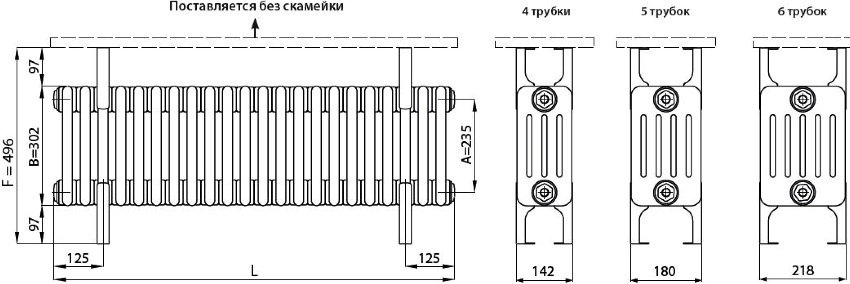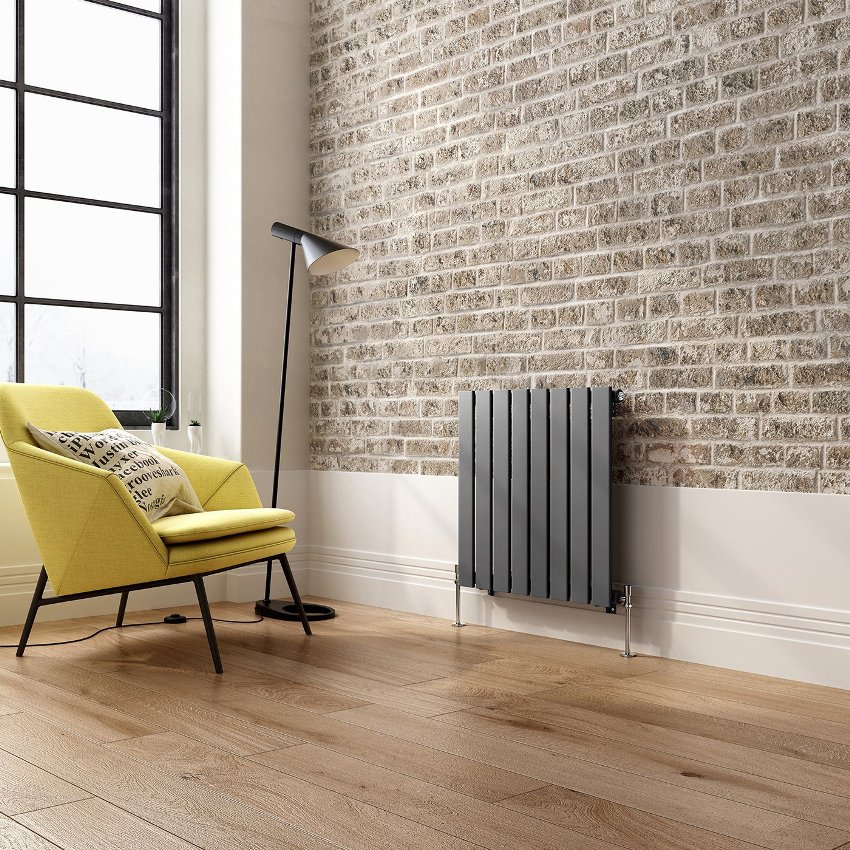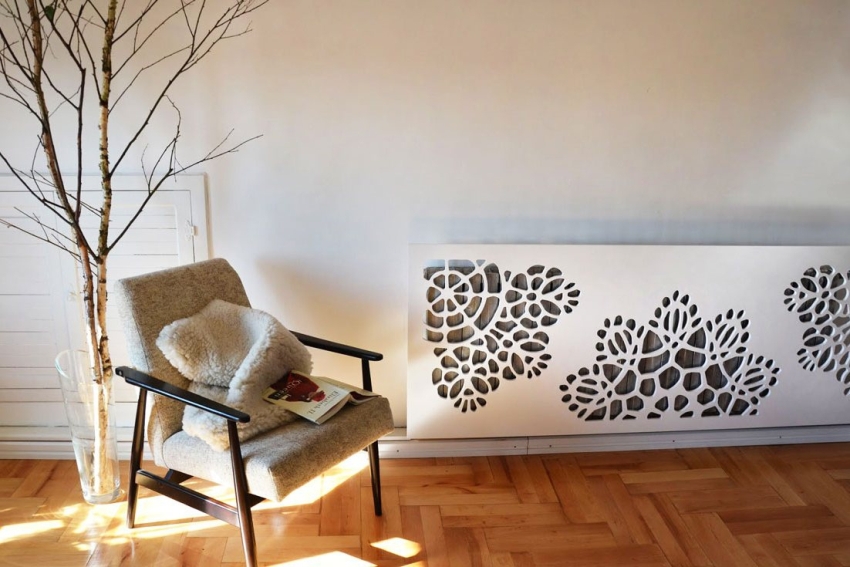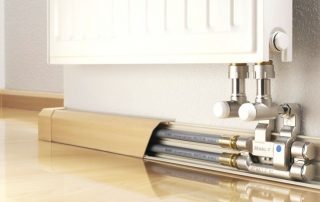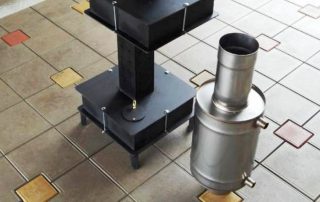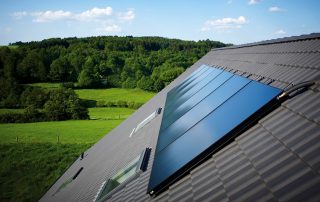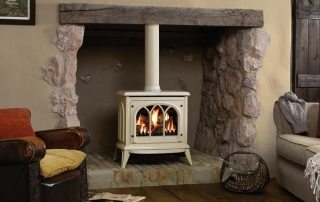The choice of heating batteries is a serious event, on which not only the efficiency of heating residential premises depends, but also the operational life of the heating communication as a whole. In multi-apartment buildings, the risk of water hammer is higher than in private houses, due to the connection to the centralized heating network. Therefore, the article will consider in detail the question of which heating radiators are best for an apartment.
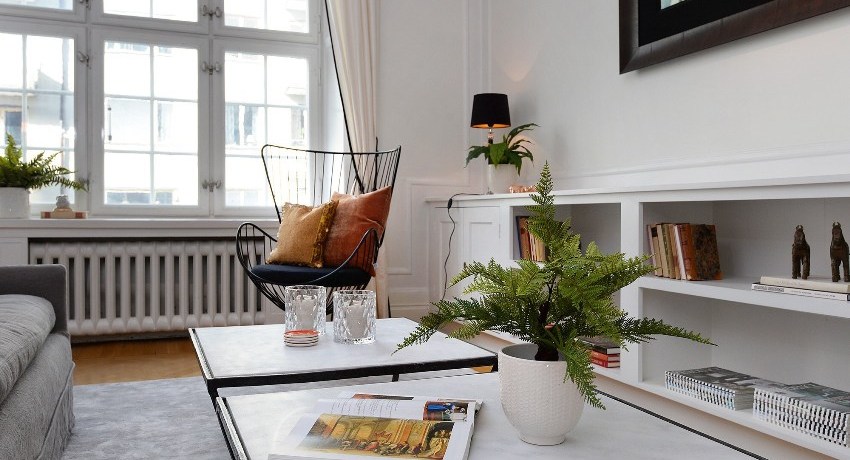
When choosing a heating radiator, you need to take into account the peculiarities of domestic heating systems, as well as choose the right material, power and the number of its sections
Content [Hide]
- 1 Features of centralized heating networks
- 2 Which radiator to choose: varieties of heating batteries
- 3 Varieties of steel heating batteries for an apartment
- 4 Which radiators are best for an apartment: an overview of aluminum models
- 5 Bimetallic heating radiators: which ones are better for an apartment?
- 6 What heating batteries are best for an apartment: prices and features of copper batteries
- 7 Vertical heating radiators for an apartment from different materials
- 8 What kind of heating battery to buy for an apartment: the main selection criteria
- 9 What heating batteries are best for an apartment: professional advice
- 10 How to calculate the power of radiators and the number of sections?
- 11 Heating battery prices from different brands
Features of centralized heating networks
The supply of coolant to the apartments is carried out by connecting to a centralized heating network (DSP). The movement of the coolant in such systems is compulsory. The supply of liquid to each apartment is carried out by means of special pumps, which are part of the DSP. The pressure generated by the pumps averages 16 atmospheres.
Helpful information! When choosing a heating radiator, first of all, it is recommended to pay attention to how often pressure surges in the communication occur. In order for a battery to withstand a water hammer, its material must have a sufficient margin of safety.
A fairly common phenomenon that centralized communications are subject to is a violation of conservation. This usually happens during the summer. At the same time, not all batteries are able to withstand water hammer that occurs during such a depressurization in the system.
Individual elements of the DSP wear out over time, which entails a deterioration in the quality of the coolant and the ingress of various foreign impurities into it. They can be technical impurities, particles of rust, dirt and various sedimentary elements. The presence of the former in the working environment negatively affects its heat output during circulation through the DSP. The rest contribute to the narrowing of the lumen of pipes and radiators, which also reduces the efficiency of heating residential premises.
When replacing a heating device in an apartment, check the compatibility of the materials from which the batteries and connecting elements (fittings) are made. The incompatibility of metals leads to their oxidation, which often becomes the cause of emergency situations in the DSP.
Which radiator to choose: types of heating batteries
Today you can find a variety of batteries for installation in apartments. All of them are subdivided into types according to several criteria. First of all, all heating radiators are classified according to the material from which they are made:
- cast iron;
- steel;
- aluminum;
- bimetallic;
- copper.
And also, depending on the design, they can be:
- sectional;
- panel.
Each of the above types of heating devices is suitable for use in certain conditions. It should also be said that there are highly specialized models that are used to perform one function. This type includes floor-type convectors used in rooms that have a large glazing area. Their use eliminates the possibility of fogging windows.
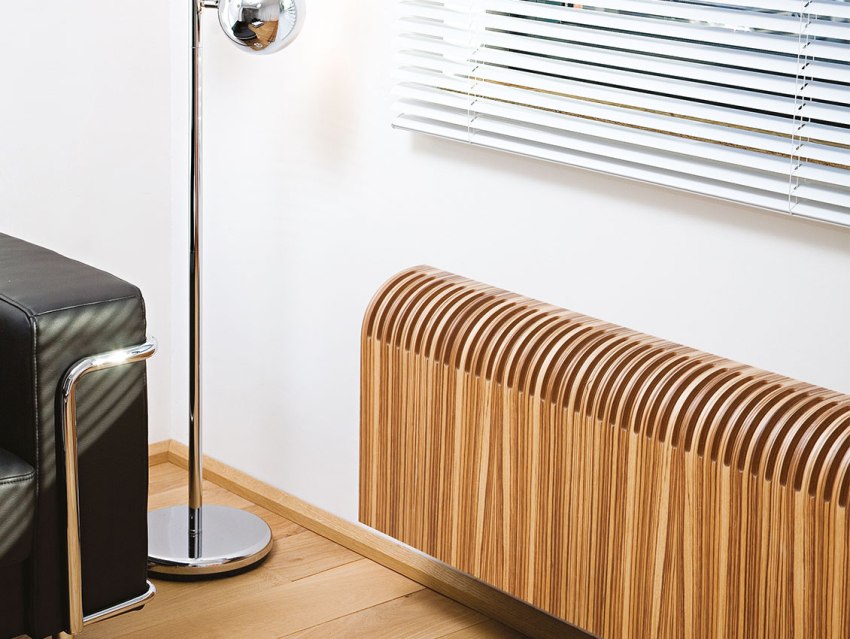
When deciding which radiators are best for an apartment, it is preferable to choose devices that have more heat output
On the market you can find another type of convectors - skirting. They are installed in special metal boxes that replace classic skirting boards. The main advantage of such heating devices is that they do not disturb the overall interior of the room.
A wide variety of batteries can be found today in terms of design. The range of modern heating radiators is incredibly wide and varied. The disadvantage of batteries made in a unique design is their price. Therefore, such heating devices are not in high demand.
Characteristics of cast iron batteries for an apartment
Not so long ago, cast iron heating devices were the most popular and were used almost everywhere. But today these bulky structures covered with enamel paint have receded into the background. With the development of manufacturing technologies, more efficient and wear-resistant steel radiators, as well as devices from other materials, have appeared.
Note! Cast iron material has a high thermal conductivity coefficient. It is also worth saying that it heats up for a long time, but at the same time it cools down just as long.
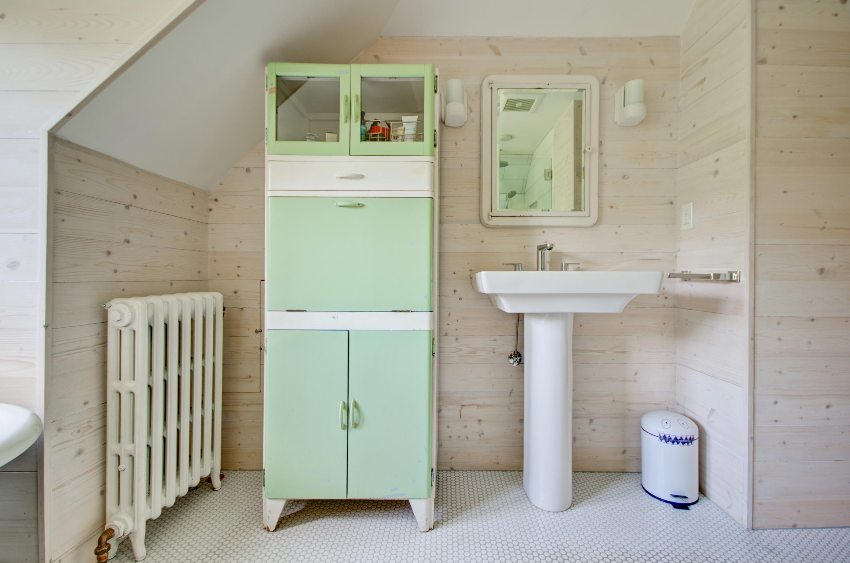
Among the advantages of cast iron is its inertial heat transfer, which especially increases due to an increase in the thickness of the metal
Cast iron batteries are able to withstand a fairly high pressure (up to 30 atmospheres), which exceeds the standard DSP indicators by 2 times. Thus, devices made of this material are highly resistant to water hammer in the system.
Among the advantages of cast iron radiator batteries, one can also highlight the fact that they are compatible with pipes and fittings made of other materials.This saves money, since when replacing the battery, there is no need to replace the associated communications.
And also cast iron products are distinguished by their resistance to destructive corrosive effects. They are unpretentious in terms of the quality of the work environment that moves through them. Long-term interaction of the inner surface of the cast iron battery with water leads to the formation of a dark deposit, which has antioxidant properties. Therefore, with normal use of such radiators, they can serve for more than a dozen years.
Modern radiators made of this material are coated with special protective enamel at the production stage. Unlike old cast iron batteries, the new models do not require annual painting, and are also easy to clean, as they have a smooth, glossy surface. Among other things, cast iron heating devices do not accumulate gases, therefore they do not need to release excess air.
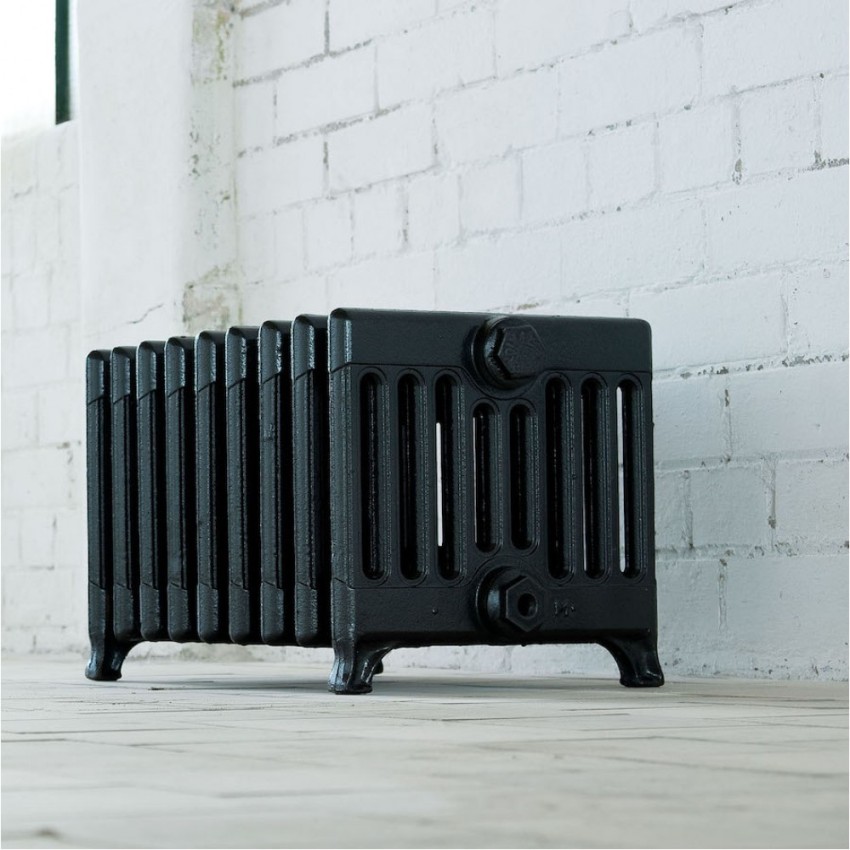
The ability to withstand high pressure and water hammer is a positive characteristic of cast iron radiators
During the Soviet era, such radiators were manufactured in large quantities and had standard dimensions. Today, the lineup of these devices offers customers almost unlimited options for cast iron products, which differ in shape, design and color. A wide range allows you to increase the operational area of such radiators.
Western companies engaged in the production of cast iron radiators produce special designer lines of heating devices. These batteries are made in a fashionable retro style and are equipped with various ornaments. Of course, the cost of such products is an order of magnitude higher than ordinary cast iron, but their quality and presentable appearance are beyond doubt.
Cast iron structures are selected depending on the size of the room. If necessary, the number of sections can be increased or decreased, which is very convenient. Let's consider what factors influence the choice of the number of sections:
- room area;
- size of windows;
- Number of doors;
- features of the climatic region.
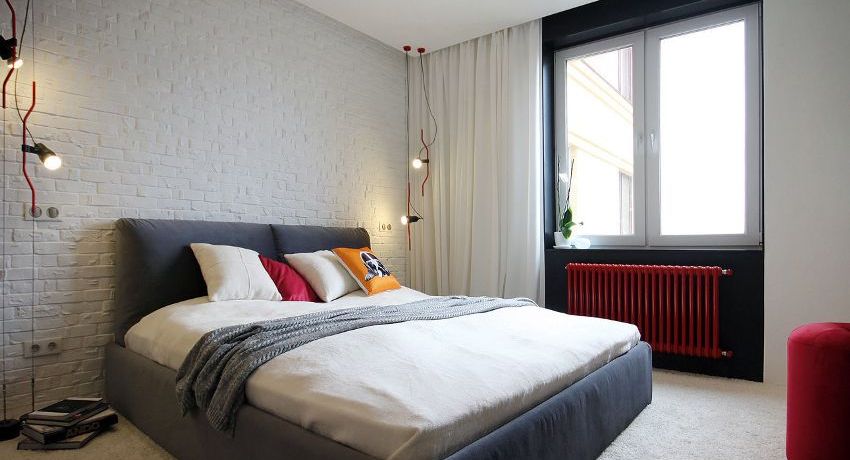
Cast iron radiators are distinguished by their durability - their service life, with proper operation, is at least 50 years
Cast iron structures also differ in filling volume. For example, in domestic radiators it is 1.3 liters, and in foreign ones - 0.8 liters. The cost of the latter is approximately 2-3 times higher. Brackets are used to install cast iron radiators in an apartment. It is also worth noting that some models are fixed directly to the floor.
Why is it better to refuse to buy cast iron: an overview of the disadvantages
As mentioned above, cast iron radiators are no longer as popular as they used to be. This is due to their disadvantages. The main disadvantage of these products is their large weight, due to which their storage, transportation and installation are accompanied by certain difficulties.
Note! For fastening a standard cast iron structure, it is necessary to use bulky fixing elements - brackets.
It is also worth mentioning that, in terms of design, standard cast iron products are not very presentable. They are categorically unsuitable for modern-style rooms. Another disadvantage of cast iron heating batteries is low inertia. With such a battery, it will not be possible to perform operational regulation of the temperature regime in the room, and for autonomous heating systems this property is especially important.
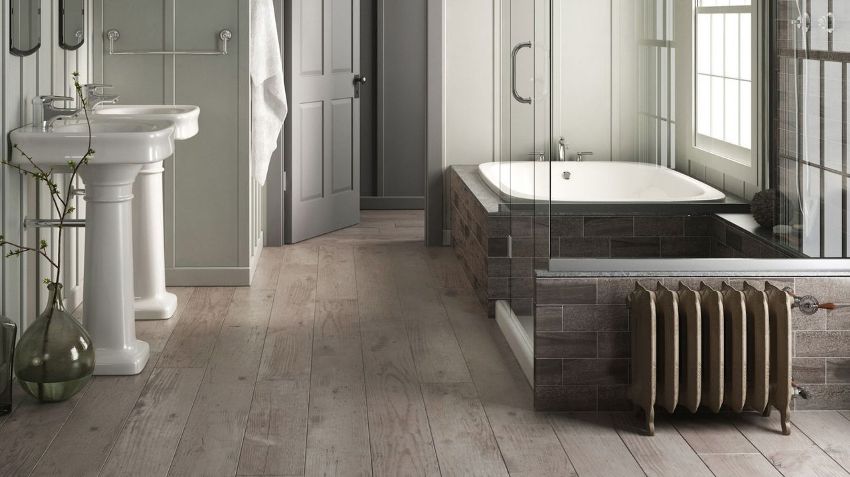
The disadvantages of cast iron batteries are their heavy weight and not particularly aesthetic appearance.
Cast iron structures do not differ in strength characteristics and are especially susceptible to mechanical stress (shock).It is because of the above properties that these products are not in great demand in the modern heating equipment market.
Varieties of steel heating batteries for an apartment
Steel radiators are among the most popular today. They are distinguished by a mass of positive qualities, and are also quite presentable and suitable for almost any room design.
There are three main types of these products, which differ from each other in their design:
- panel;
- tubular;
- lamellar.
Each of these types is suitable for certain conditions and has its own advantages and disadvantages. In order to answer the question of which heating radiator is better to choose for an apartment, it is necessary to consider the features of both panel and tubular, as well as convector structures.
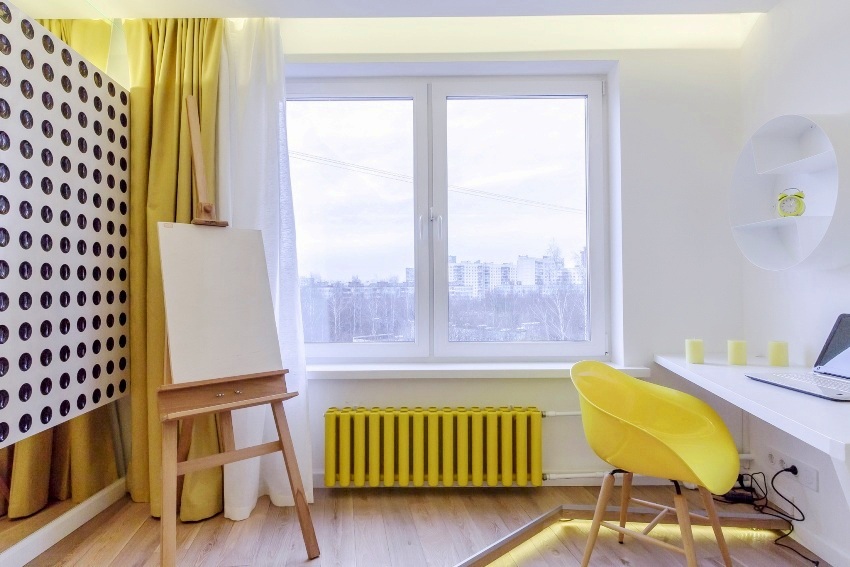
Depending on the model, manufacturer and many other factors, a tubular heating radiator can have a wide variety of technical parameters.
What heating radiators are best for an apartment: panel batteries made of steel
The panel structure includes two steel sheets. Through stamping, they are given the required shape. After that, the resulting blanks are joined by welding, which makes it possible to obtain a hollow panel. If necessary, it is supplemented with convectors, thanks to which the air moves in a vertical direction. This allows you to perform a kind of "barrier" that protects the room from the cold coming from the window.
After assembling such a radiator, it is painted. The protective coating is a very important element of the design, as it protects it from corrosion, makes it more presentable, and also contributes to its maintenance. When choosing a new steel battery, special attention should be paid to how evenly the paint layer is applied to the panel. It should not contain gaps, cracks or chips.
Steel structures are able to withstand temperatures up to 95 ºC. They are designed for the standard pressure that is created inside the DSP, namely: 16 atmospheres.
Helpful information! Steel batteries of this type can have a different number of convector elements and panels.

Panel radiators are made of two stamped metal sheets connected in such a way that channels are formed between them through which the coolant circulates
The length of such radiators ranges from 40 cm to 3 m. The minimum height of such a structure is 20 cm, and the maximum is 90. Some companies are engaged in the production of steel heating devices of this type on order, which also expands their model range, and, accordingly, operational sphere.
Related article:
Convector type heaters: advantages and features of choice
Description of the principle of operation, comparison of heaters. Survey of types, firms and prices of convector heaters.
Depending on where the heating device will be docked with the pipe, there are two main options for steel devices:
- with bottom connection;
- with side connection.
When choosing a steel radiator, you need to pay attention to the location of the heating pipes in your apartment. Based on this, the required design is selected, with the desired connection option.
Advantages and disadvantages of steel panel radiators
In order to answer the question of how to choose a heating radiator for an apartment, you need to familiarize yourself with the pros and cons of steel panel structures. Such models are the most common today. To begin with, consider the positive qualities of these heating devices.
The first and, perhaps, the most important advantage of the panel construction is its ease of installation. Installation in the heating circuit is done quite quickly according to the instructions.If necessary, you can do it yourself. In addition, the design of the radiator eliminates the need for assembly, as it is one-piece, which also saves time.
Panel radiators are highly inert, therefore they warm up very quickly. Thanks to this, they can be easily adjusted to the required temperature regime. And also such steel structures have a rather large area, which contributes to the rapid and efficient heating of the room.
Steel panels in the form of panels are compact in size and have an attractive, modern appearance. Such models are most suitable for apartments equipped with an autonomous heating system. This is due to the fact that a minimum amount of coolant is required to fill them.
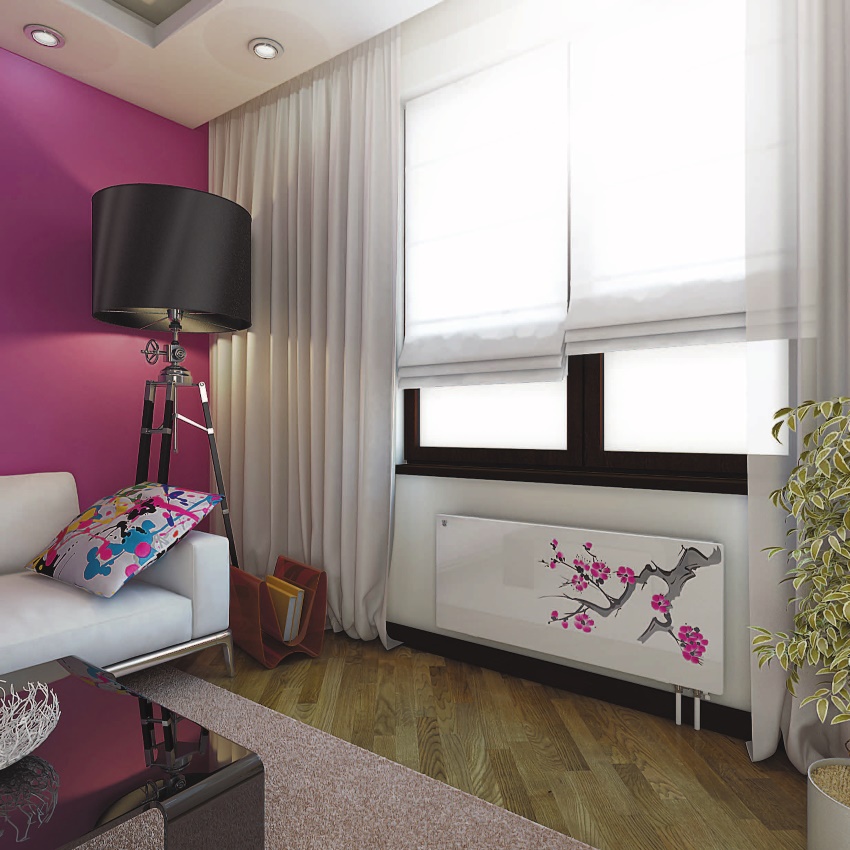
The disadvantages of panel radiators include low operating pressure, high sensitivity to all kinds of shocks, including hydraulic ones, as well as exposure to corrosion
Like any other product, steel panel batteries have their drawbacks. The main one is that they are not designed to withstand strong water hammers. They are reliable only at normal DSP pressure. However, this problem can be dealt with. When installing a panel structure in an apartment, it is recommended to use a special device - a reducer. This device allows you to reduce the level of load on the panel during a water hammer.
The inner walls of such radiators, as a rule, are not equipped with a special protective coating against corrosion. It follows from this that their shelf life will depend on how high-quality coolant circulates through them.
Tubular (sectional) steel batteries
Unlike the previous type of steel radiators, such batteries include several sections. The fixation of these elements to each other is done by welding. Such products do not need assembly, which is undoubtedly their plus.
Note! How to choose a tubular type battery? Before buying a tubular heater, a mandatory item is the selection of the required power. This indicator is calculated taking into account the total area of the room, which will be heated by the sectional model.
Sectional heating devices are used in systems whose pressure ranges from 8 to 10 atmospheres. As a rule, this is not enough for multi-apartment buildings heated by DSP. Therefore, experts recommend when using such models to purchase a gearbox that is able to protect the tubular battery from water hammer.
The standard wall thickness of sectional gearboxes is 1-1.5 mm, therefore they have a high inertia coefficient. But the small thickness of the walls is also a disadvantage of such products, since they differ in rather weak strength characteristics.
Tubular structures are distinguished by good resistance to contaminated coolant environment. Unlike panel models, their inner surface is equipped at the production stage with a special protective layer made of polymer material. Thanks to this, they are resistant to corrosion and have a longer service life.
These devices are available in different sizes. The width depends on the area of the room and the number of sections. Height can vary from 0.2 to 2.5 m, and depth - from 10 to 25 cm.

Basically, tubular radiators are made of high quality steel, which is light in weight and can withstand heavy loads.
Sectional products have two main disadvantages:
- low heat transfer coefficient;
- the presence of welds that are unstable to water hammer.
Thus, sectional batteries are a good option for installation in autonomous heating communications.However, they are not quite suitable for use in DSP conditions, since they are susceptible to water hammer.
Choice of tubular batteries, depending on their design
Many apartment owners are interested in the question of which heating radiator to choose, depending on the design. Tubular steel batteries (and not only) are a common solution for installation in an apartment. The range of such devices is distinguished by a variety of design solutions. Depending on the location of the sectional radiator, you can purchase a wall or floor product.
Such devices are mounted at different points in the dwelling. For example, the most common option is to install a tubular battery under a window, however, the location can be any if desired. They are often used for installation in the center of the room (vertical version). In this case, the height of the battery matches the height of the ceiling.

With the help of tubular radiators, you can not only fully heat the room, but also make it more attractive
Helpful information! Some sectional radiators include special wooden panels that are mounted on the top of the appliance and act as a work surface. Such a shelf can be adapted for a variety of needs, but is most often used to dry shoes.
The presence of a wide model range of shapes, a variety of colors and the presence of additional structural elements significantly expand the operational area of such steel products.
Plate heating radiators made of steel (convectors)
The working medium in the plate radiator moves along straight or curved steel pipes. Plates made of the same material are attached to them. The purpose of these elements is to increase the thermal efficiency of the structure.
The plate batteries are resistant to water hammer. It is also worth saying that the steel rods located inside the structure are heated to quite high temperatures. However, they are covered by a protective casing, the temperature of which is no more than 40 ° C.
Such designs are great for use in rooms with high ceilings. This is due to the fact that the heated air is steadily moving upward and can rise to a fairly significant height. If necessary, you can independently adjust the temperature regime in which such a heater will function.
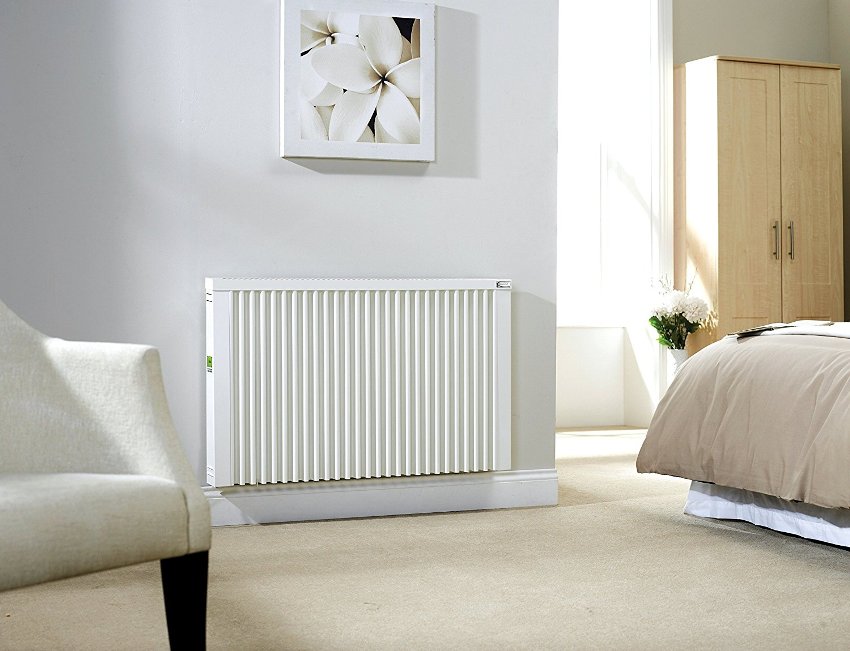
Plate heaters are so called because they are made of several plates, mounted on curved or straight pipes.
The plate batteries are capable of withstanding standard DSP pressure (16 atmospheres). And the maximum pressure indicator for them is 24 atmospheres. It follows from this that convector structures are suitable for use in multi-apartment buildings. The price of a battery for heating this type is on average 6-9 thousand rubles.
Such heating devices also have some disadvantages. For example, the vertical orientation of the heated air movement is not only the positive, but also the negative side of the plate product. This is due to the fact that the room is heated unevenly.
Convector plates are very quickly contaminated with dust, which affects the heat transfer coefficient. Cleaning these elements is quite difficult. It is also worth noting that such devices do not differ in aesthetics and are not suitable for every interior. Such batteries are most suitable for installation in rooms with high ceilings. They are often installed in corridors, swimming pools, etc.
Which radiators are best for an apartment: an overview of aluminum models
Structures made of aluminum differ in their appearance, as they have a stylish design. However, such products are not the best option for installation in apartments with DSP.This is due to the fact that the aluminum structure has rather thin walls, unstable to the destructive effects of corrosion. Given the low quality of the coolant, such a battery can fail after 5 years of operation.
Helpful information! For apartments that are heated by autonomous heating communications, an aluminum radiator can be a good option. A high coefficient of thermal conductivity, as well as a presentable appearance are the main advantages of such products, thanks to which the demand for them remains good.
Aluminum models are designed for operation in systems with a pressure of 15-20 atmospheres. However, the thin-walled structure used in DSP cannot boast of resistance to water hammer. Considering this fact, it should be said that a radiator for a house of this type is best suited for installation in conditions of autonomous heating.
Experts advise not to use such batteries if the pressure in the communication exceeds 12 atmospheres. As for the quality of the coolant, aluminum structures function best with a Ph value of 5-6 units, which is a rarity in domestic DSPs.
Such heating devices are lightweight, so they are easy to store, transport and install. It is important to remember that the installation of such a battery requires not only care, but also the selection of fittings from a compatible material. Otherwise, corroded areas are formed at the joints. Consider the materials that absolutely cannot be used when installing an aluminum battery:
- steel;

Aluminum batteries are susceptible to corrosive processes, therefore the inner layer of radiators must be protected from contact with the coolant
- brass;
- copper.
The ideal option for installing an aluminum radiator is a plastic heating circuit. In this case, the occurrence of corrosion is excluded, and the heating structure itself is simple for repair or dismantling.
Today you can find a wide selection of aluminum products. They differ in size, color and design. The height of such products ranges from 25 to 50 cm, however, if necessary, you can order a non-standard model (70-80 cm).
Experts note that such batteries have excellent compatibility with thermal control equipment. When installing an aluminum structure, it is recommended to select a thermostat in advance. They also have a glossy surface, so in case of contamination it will not be difficult to clean such a radiator. How to choose an aluminum heating battery, depending on the brand?
If we talk about firms that produce aluminum radiators, then the most popular among consumers is ROYAL THERMO. Products from this brand are of good quality and reasonable cost. Such radiators are specially adapted for use in the CIS countries. They are distinguished by good corrosion resistance and long service life (over 10 years).
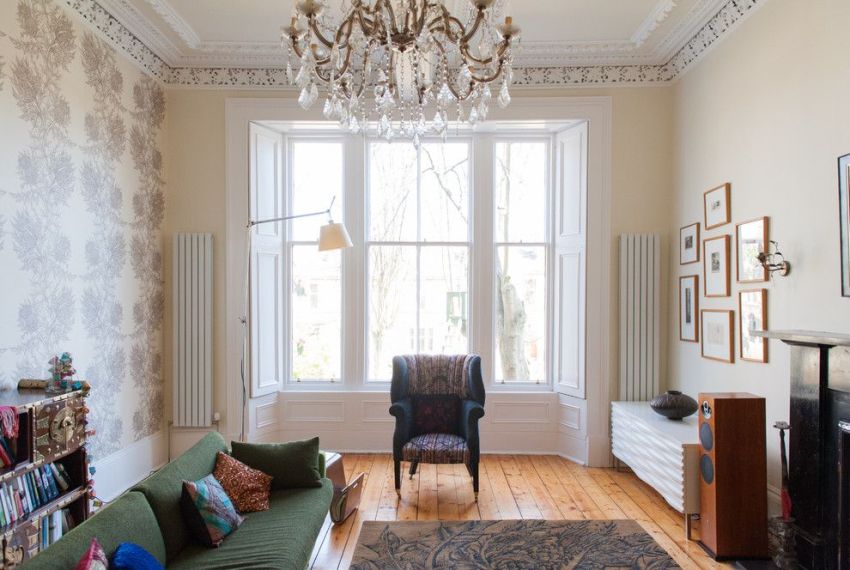
Lightweight, with excellent heat transfer models of aluminum batteries attract consumers not only with their technical characteristics, but also with a pleasant appearance.
Anodized aluminum batteries - ideal for an apartment
Aluminum heaters can be made with a special anti-corrosion coating, which is called anodic. For the production of such batteries, a high-quality aluminum alloy is used, which is pre-cleaned, and a layer of an oxidized anode is applied to the surface.
The technological process of manufacturing such products is rather complicated.During it, the structure of aluminum undergoes several changes, which is a kind of hardening. Thus, the end product is highly resistant to corrosion and can be used in DSP conditions.
Such radiators are made by casting. After that, the resulting sections are assembled into a single structure. One of the main advantages of such products is that, if necessary, you can repair the heating radiator in the apartment. Replacing a section that has been damaged is quite simple due to the design of the heater.
Helpful information! Additional sections can be added to the anode battery if required.
The inner walls of such models are smooth, which promotes heat transfer. The coolant moves without any difficulty along the aluminum structure. The working pressure of the anode products is 20-25 atmospheres, which is much higher than needed in an apartment building with DSP.
When purchasing such a heater, experts advise you to be careful. This is due to the fact that anode products outwardly do not differ in any way from ordinary cast radiators. Therefore, before buying this or that model of this type, it is recommended that you familiarize yourself with the documents for it. Checking the passport and quality certificate allows you to avoid problems when buying an anode radiator.
Bimetallic heating radiators: which are best for an apartment?
Bimetallic batteries are the most popular in the modern heating equipment market. They have many positive qualities, among which universality should be noted separately. From the name it becomes clear that two metals are used in the production of such heating devices. Combined manufacturing can significantly improve the performance of these products.
The outer part of the bimetallic structure is usually made of aluminum. This allows achieving high heat transfer rates and increasing heating efficiency. In turn, the internal channels required for the circulation of the coolant are made of high quality steel, which is resistant to corrosion.
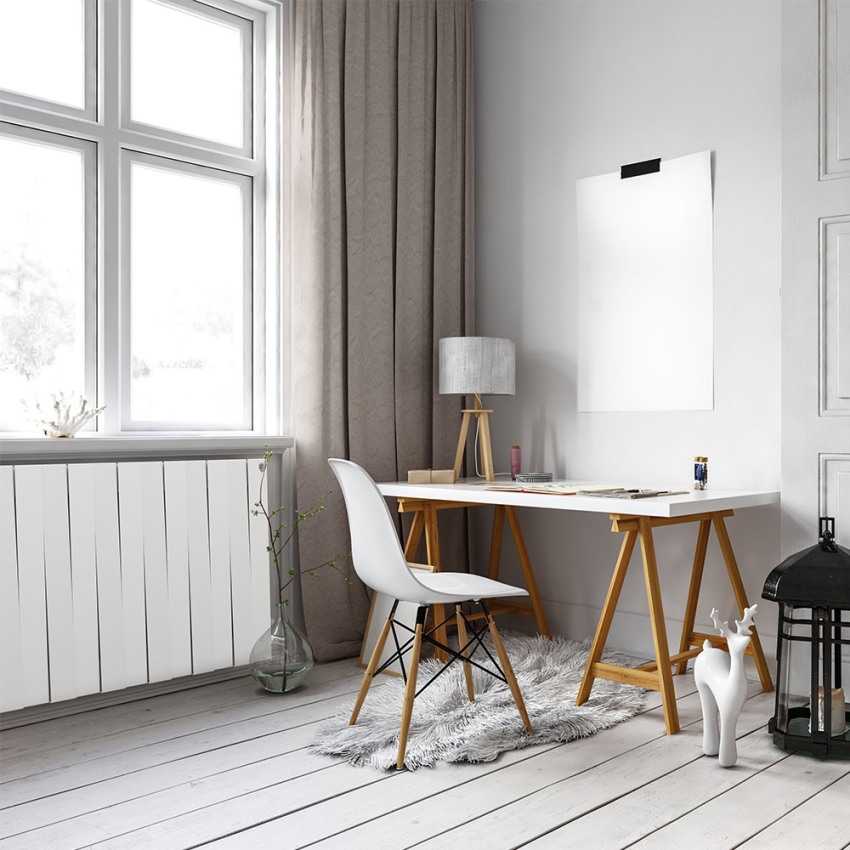
Bimetallic radiators are made of two main components: the internal elements are made of high quality steel and the external ones are made of aluminum.
Separately, it should be said that the outer part, made of aluminum, is additionally supplied with an enamel layer, which gives such radiators a presentable appearance. Bimetallic batteries have a sectional design. Docking of individual elements is carried out by means of couplings, which are supplied with O-rings.
The long service life of bimetallic heating devices is determined by their structure. The aluminum shell does not come into contact with the working medium and serves as a kind of "case" for the internal channels of steel, along which the coolant moves.
The steel part of the bimetallic radiator is highly resistant to system loads. Such products are capable of functioning at very high pressures (35-40 atmospheres). This makes them perfect for installation in DSP heated apartments.
And also such radiators are lightweight, which simplifies their installation in the apartment. Of the minuses of such products, perhaps only one can be noted - a rather high cost. However, their quality characteristics and shelf life fully justify the price.
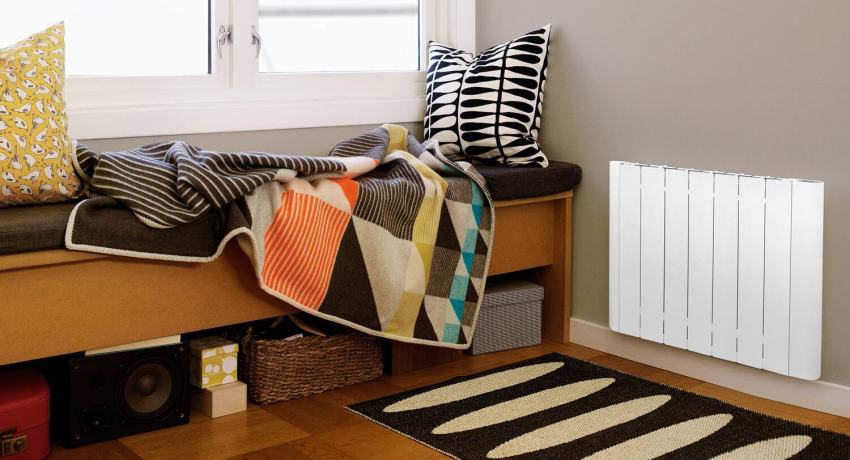
The external view of bimetallic radiators is sometimes compared with analogs made of aluminum, but the former will cost much more.
If we talk about choosing the best bimetallic heating radiator for an apartment, then you need to pay attention to several popular models. Among them: SIRA RS BIMETAL 500, GLOBAL STYLE PLUS 500, as well as RIFAR MONOLIT 500. Each of these models has proven itself well in an apartment building with a central heating circuit.
What heating batteries are best for an apartment: prices and features of copper batteries
Batteries made from this material occupy the smallest segment on the heating appliance market. Their low popularity is primarily due to the fact that they are quite expensive. However, they are distinguished by high technical characteristics and in this they can compete even with bimetallic products.
Such batteries are made from high quality copper material, which does not have foreign impurities that can reduce the efficiency of the device. Such radiators have a number of positive qualities, although they are rarely used when replacing radiators in an apartment. The main advantage of such products, of course, can be called high efficiency, which is 4-5 times higher than that of cast iron models.
Another advantage of heating devices made of this material is a high coefficient of inertia. They are able to heat up quickly, which contributes to efficient heat transfer. And also copper structures are distinguished by high strength characteristics and resistance to hydraulic shocks. They are capable of functioning in systems with a pressure of 20-25 atmospheres, which exceeds the standard indicators in DSP.
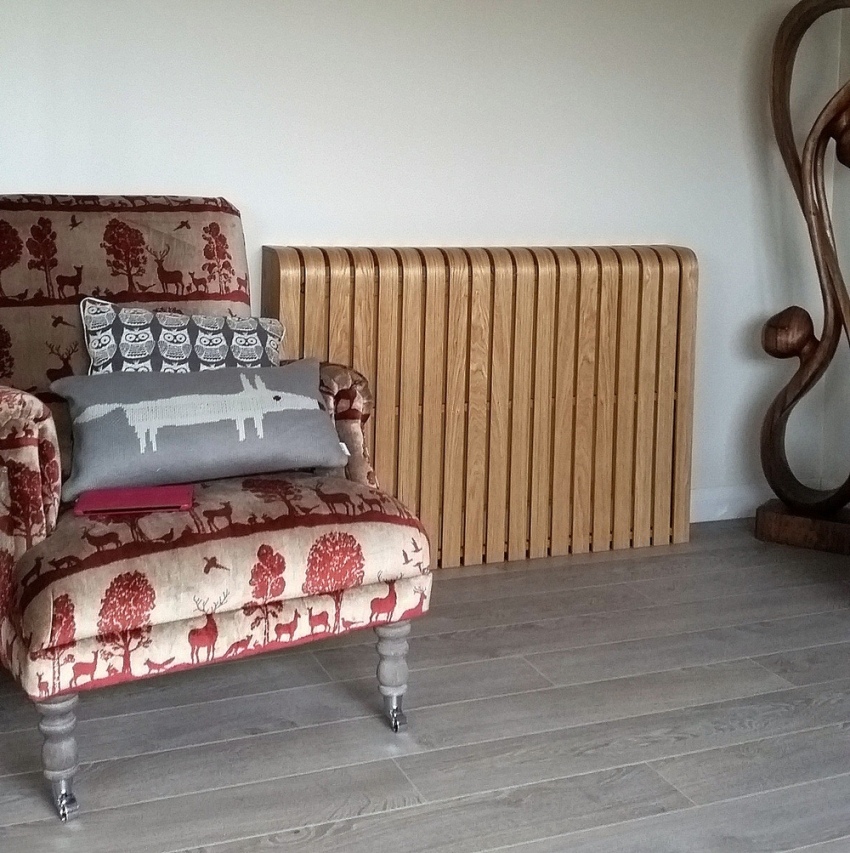
The heating system with copper batteries is not afraid of water hammer - the softness of the metal contributes to an even distribution of loads and prevents depressurization
Helpful information! If the coolant is not water, but antifreeze, then the use of copper radiators is the only solution.
It is also worth noting that such heating devices do not need to be painted, as they have high anti-corrosion properties. The service life of copper products exceeds 10 years. They have a presentable appearance and due to this they can become an adornment of any interior, especially one decorated in a classic style.
It is important to remember that for such batteries it is necessary to select fittings from the same material in order to exclude the possibility of an oxidation reaction occurring.
Vertical heating radiators for an apartment from different materials
Vertical radiators have several advantages over devices that are mounted in a standard way. They are lightweight, versatile and easy to install. Tall batteries are an excellent solution if there is not enough free wall space to install a conventional device. Vertical models are made from different materials:
Cast iron. Tall heating devices made of this material are quite unpretentious. For them, the quality of the coolant does not matter. They have a good heat transfer coefficient, as well as resistance to water hammer. They are located in the middle price segment. The disadvantages of such high batteries are that they are heavy, which makes them difficult to install.
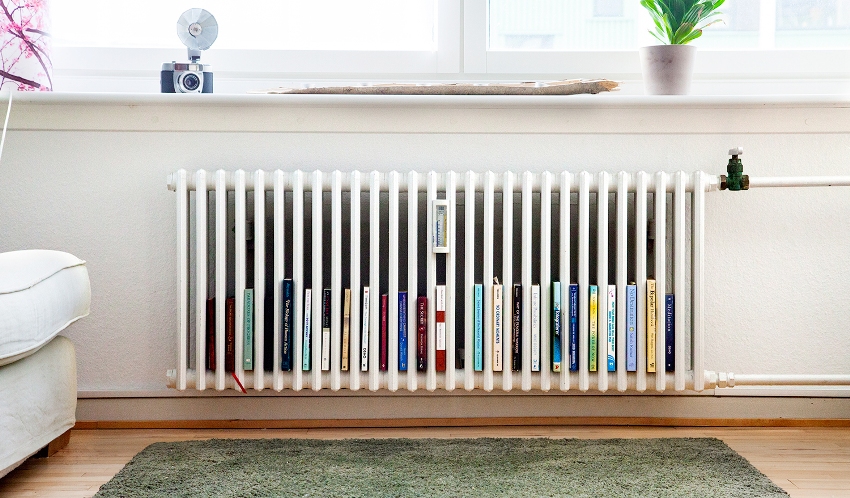
The material used for vertical radiators is not limited, they can be metal, bimetallic, glass, wood, stone
Steel. Experts recommend using steel panel structures in apartments. The wall thickness of such batteries ranges from 1 to 1.5 mm. The outer walls of such products are equipped with a protective layer of enamel, which also makes them aesthetically pleasing. Tall steel radiators are susceptible to hydraulic shocks and are most often used in private houses equipped with an autonomous heating circuit.
Tall heating devices are distinguished by their efficiency and aesthetics.You can buy a vertical heating radiator for an apartment in any specialized store, or place an order online. When purchasing steel devices, it is recommended to pay special attention to whether they have a protective anti-corrosion layer.
Aluminum. Tall aluminum batteries are low temperature. They provide space heating due to their size. The temperature of the working environment in such radiators ranges from 60 to 70 ° C. They are capable of providing a standard temperature regime in the room (from 20 to 24 ° C). Aluminum vertical radiators are lightweight and also have the ability to add sections. Such products are most often used in autonomous heating circuits.
Bimetallic. They are characterized by high quality and efficiency due to the use of two metal shells (aluminum and steel). Best suited for use in multi-family residential buildings.
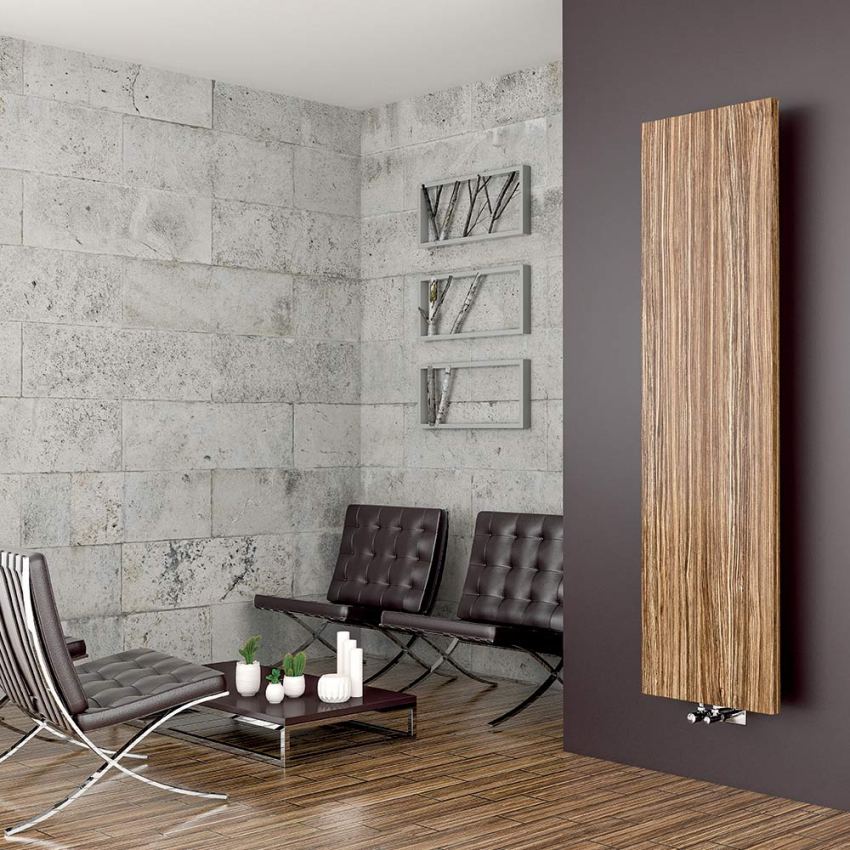
Vertical radiators can be manufactured in the form of sections and monolithic, fixed size and on request
What buy heating battery for an apartment: basic selection criteria
Before buying a heater for an apartment, you need to pay attention to a few basic points. There are certain criteria, the study of which will answer the question of how to choose a radiator. Heating batteries must meet all the necessary technical characteristics, have a passport and instructions.
Let's consider the main factors by which it is necessary to select a battery for an apartment.
Operating pressure. The operating pressure must be indicated in the documentation for the heater. Experts recommend purchasing batteries with a certain margin. The operating pressure of the battery should exceed the same indicator in the central heating circuit by approximately 1.5 times. This will allow you to play it safe, since pressure surges often occur in the DSP.
Note! In five-storey buildings of the old design, the pressure in the heating circuit is about 6-8, and in modern high-rise buildings - 10-15 atmospheres.
Resistant to water hammer. This factor has a direct impact on the operating life of heating equipment. If a gearbox is not installed in front of the radiator, then the water hammer will act on the structure with full force. When choosing a battery, it is recommended to take into account the specifics of the heating circuit in your home.

In apartments with centralized heating, it is recommended to use cast iron radiators, which are most resistant to corrosion and have a long service life
Number of sections. If, when choosing a heater, there are difficulties with determining the required number of sections, then it is recommended to pay attention to the models that can be "built up" if necessary.
Power. This indicator is perhaps the most important. Not all heating devices are capable of maintaining the required temperature regime in a residential area. This is especially problematic in the northern regions, where temperatures can drop by 40 ° C below zero. In such situations, experts advise choosing models that are capable of withstanding the high temperature of the coolant (up to 130 ° C).
The temperature in the heating radiator in the apartment must meet the necessary standards and provide a suitable microclimate in the room. To date, it has been established that the temperature of +18 ° C is considered the norm for a living room. For corner rooms, the walls of which are in direct contact with the street, this figure is increased by 2 ° C. Therefore, when choosing a heater, it is necessary to calculate its power, taking into account specific operational features.
The composition of the coolant.Do not forget that the characteristics of the working environment circulating through it also influence the battery life. High quality of the heat carrier is a rarity. As a rule, it includes various harmful (for radiator walls) impurities. Therefore, it is necessary to select a structure with thick walls or a protective coating.
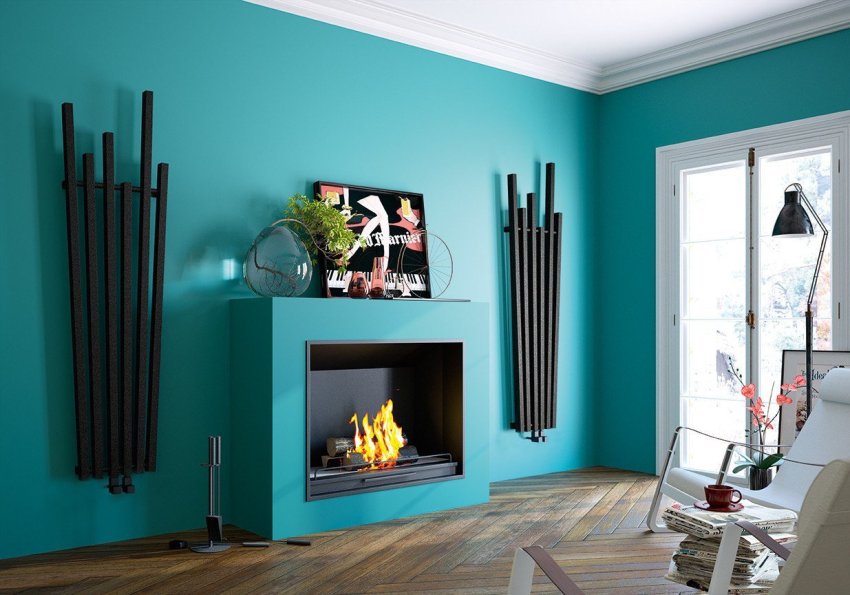
Today, innovative solutions have come out to replace the old cast iron and standard steel batteries - designer radiators that surprise with a variety of their shapes, colors and mounting methods.
Radiator design. This factor is completely individual and depends on the preferences of the owners of the apartment, as well as the interior features.
Easy to install. This criterion is not required. However, if you decide to install the heating structure yourself, then you should select products that are lightweight. And also to study the options for fasteners and the features of connecting a particular model to the heating circuit.
What heating batteries are best for an apartment: professional advice
So which heating radiators are better to put in an apartment? Experts recommend consulting a plumber before purchasing a heater. In any case, you will need to find out the features of the DSP and the coolant, including:
- pressure in the heating circuit;
- Ph of the working environment;
- Coolant temperature.
After receiving all the necessary information regarding the heating circuit, it is recommended to inquire about the surges occurring in the system. This data will help you choose the right radiator in terms of parameters.
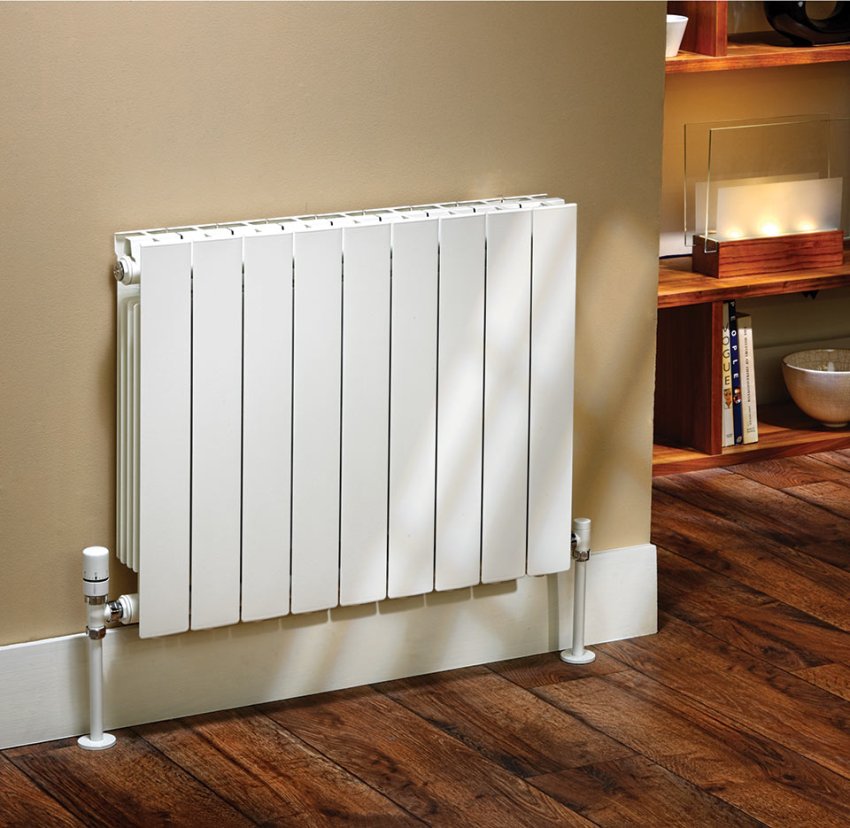
In order to choose the right type of radiator for an apartment, it is necessary to study the characteristics of each of them
Helpful information! For residential buildings that have more than 12 floors, installing a bimetallic battery would be an excellent option. Also in this case, cast iron models can be used. If the working pressure indicator does not exceed 14 atmospheres, and the Ph indicator is in the range from 5 to 8, then not only cast iron and bimetal, but also aluminum and steel can be used.
If the acidity index exceeds the permissible level (> 8.5), then the use of steel and aluminum structures is strongly discouraged. In such an environment, only bimetallic heating structures can function normally. They are also suitable for DSP, the pressure in which exceeds 20 atmospheres.
Rating of heating radiators for an apartment bimetal
Among bimetallic radiators, as mentioned above, there are three main models. Consider their characteristics:
SIRA RS BIMETAL 500. This model has several main advantages, which include: high heat transfer coefficient, as well as good sound insulation qualities. Similar products are made in Italy. They are able to provide heating for rooms up to 40 m².
The number of sections for such batteries varies from 4 to 12. Also, bimetallic radiators of this model are distinguished by high quality of painting and aesthetics. The disadvantages include increased sensitivity to the working environment.
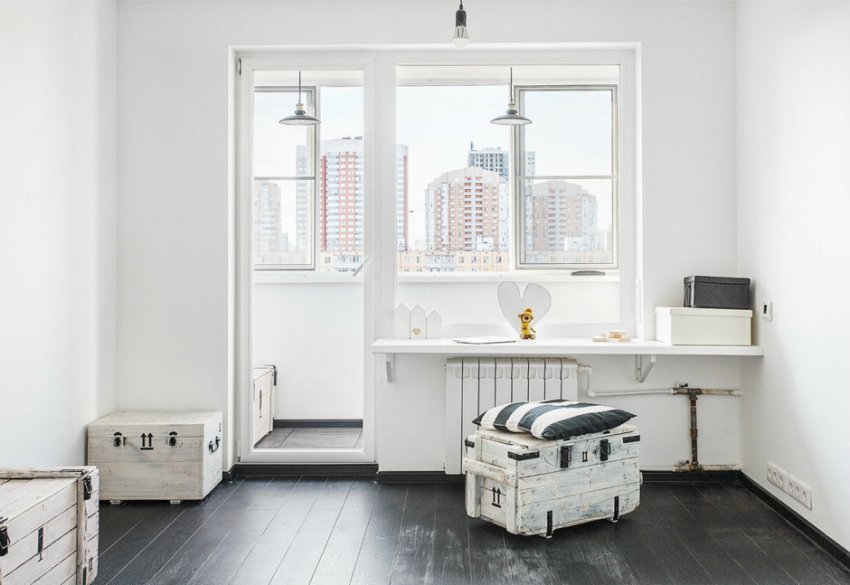
Wanting to replace an old heating radiator with a better quality appliance with decent characteristics, a person inevitably faces a difficult choice - which model to buy
GLOBAL STYLE PLUS 500. Bimetallic heater from an Italian manufacturer, distinguished by high build quality. The service life of such products is 25 years, as reported by the manufacturer. Another advantage of this radiator is its resistance to water hammer. A model of this type is capable of withstanding pressures up to 35 atmospheres. The maximum temperature indicator of the heating medium for this heater is 110 ° C.
The main disadvantage of such batteries is the enamel coating, which is notable for its uncertain quality. And it is also worth saying that the price of a heating battery of this type is higher than that of other representatives.
RIFAR MONOLIT 500. The most popular bimetallic radiator, which is highly resistant to hydraulic shocks and has an operating pressure of as much as 100 atmospheres. The company "Rifar" is located in Russia and specializes in the production of heating devices adapted to domestic conditions of use.
Such a model can have a different number of sections. The maximum heat transfer rate of such a battery reaches 2744 watts, which is quite enough to maintain the required microclimate in a room with an area of 27 m². The maximum operating environment temperature that such a battery can withstand is 135 ° C. The disadvantages of this radiator are poor sound insulation.
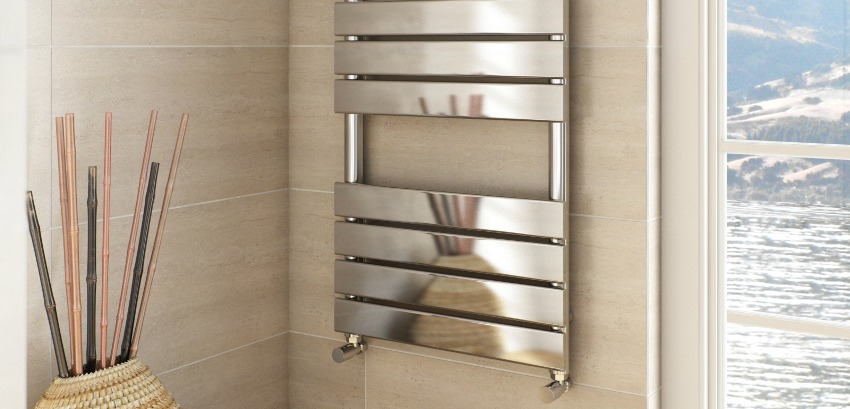
Assessing GLOBAL brand products, experts say that the company confidently occupies a leading position in this industry in terms of price-quality ratio
What heating radiators are best for an apartment: prices and characteristics of aluminum models
In turn, aluminum heating structures have many varieties. Consider those that are most popular among buyers:
THERMAL RAP-500. The company producing this model of radiators is located in Russia. Products of this type are designed to work in rather difficult conditions. The maximum operating pressure for the RAP-500 model is 24 atmospheres, which exceeds the standard values in the DSP.
Note! When buying an aluminum heating device, be sure to pay attention to its working pressure. This indicator is indicated in the corresponding documentation supplied with the radiator.
The aluminum battery of this model is resistant to hydraulic surges, therefore it is popular with buyers in Russia. The maximum temperature of the working environment that the RAP-500 radiator from the TERMAL brand can withstand is 130 ° C.
RIFAR ALUM 500. Such aluminum batteries, as in the previous case, are produced by a Russian company. They are capable of operating under severe temperature conditions (up to 135 ° C). The maximum area that a model of this type can heat is 25.6 m².
The aluminum model from this manufacturer can withstand pressures up to 20 atmospheres and is resistant to minor water shocks in DSP. Its useful life can be up to 25 years under normal use. The main disadvantage of this model is a low-quality protective coating.
ROYAL THERMO REVOLUTION 500. Aluminum radiator from the Italian brand "ROYAL THERMO" is distinguished by the fact that it has the best heat transfer coefficient among similar structures. The maximum power of such a heating device can reach 3982 watts.
Installation of such an aluminum radiator allows you to provide the required temperature conditions for rooms with an area of up to 40 m². This model is suitable for use in DSP, the working pressure of which does not exceed 20 atmospheres. Thus, we can conclude which heating radiator is best for an apartment. The price and photo of such a battery can be easily checked on the Internet.
Of the minuses of this heating equipment, one can single out the fact that they are quite demanding on the quality of the working environment. The approximate cost of the above devices ranges from 2500 to 5000 rubles. There are also more expensive options, the price of which can reach 12,000 rubles. and even higher. These include vertical aluminum heating devices.
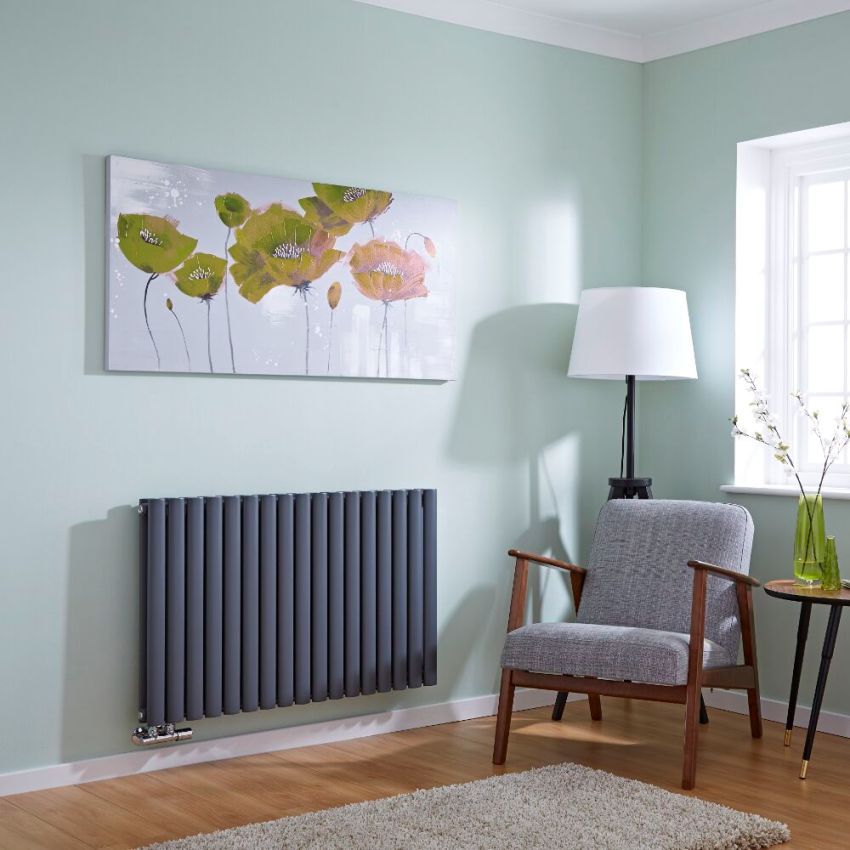
The main focus of the manufacturer of the ROYAL THERMO REVOLUTION 500 model is made on the production of resource-saving equipment that does not harm the environment
Steel and cast iron radiators: which ones are better for an apartment?
Steel radiators are notable for their democratic cost, however, they are not very popular in the heating equipment market. Consider the models that have proven themselves best in an apartment building with DSP:
PURMO COMPACT 22 500. Finnish heating equipment has always been famous for its versatility. The steel radiator of this series is no exception. This model has a convenient wall mount, as well as a high maximum power (5572 watts). The area that this battery is capable of heating reaches 50 m².
Among other things, this type of steel structure is lightweight and is the most convenient of all for self-installation in an apartment. It can be used in heating circuits with a pressure not exceeding 10 atmospheres, which is a rather tangible disadvantage.
KERMI FTV (FKV) 22 500. This model allows you to answer the question of which battery is better to put in an apartment with large rooms. It is a product of the German company KERMI. The main advantage of this type of steel radiator is that it has a high heat transfer coefficient. The panel construction helps to heat the living space. The power of such a device can reach 5790 watts.

The cost of cast iron radiators is higher than that of their aluminum and steel counterparts, but much lower than bimetallic heating devices
Helpful information! The area that can be heated by this battery is 57.9 m². Therefore, it is perfect for installation in large rooms.
A steel radiator of this type is suitable for use in heating systems with a heating medium temperature no higher than 110 ° C. The disadvantages of this model include a small indicator of working pressure (10 atmospheres) and low quality of the enamel coating.
Cast iron models have many drawbacks, but are still used in apartments. Among the variety of models from this material, one can single out one that has many positive reviews, namely: STI NOVA 500.
This radiator is the most popular among consumers. It is a product of an Italian company and has good heat dissipation. Such a battery is perfect for small rooms (no more than 20 m²). The maximum temperature of the coolant that this type of structure can withstand is 150 ° C. Of the minuses, one can single out a large mass and a considerable flow rate of the coolant.
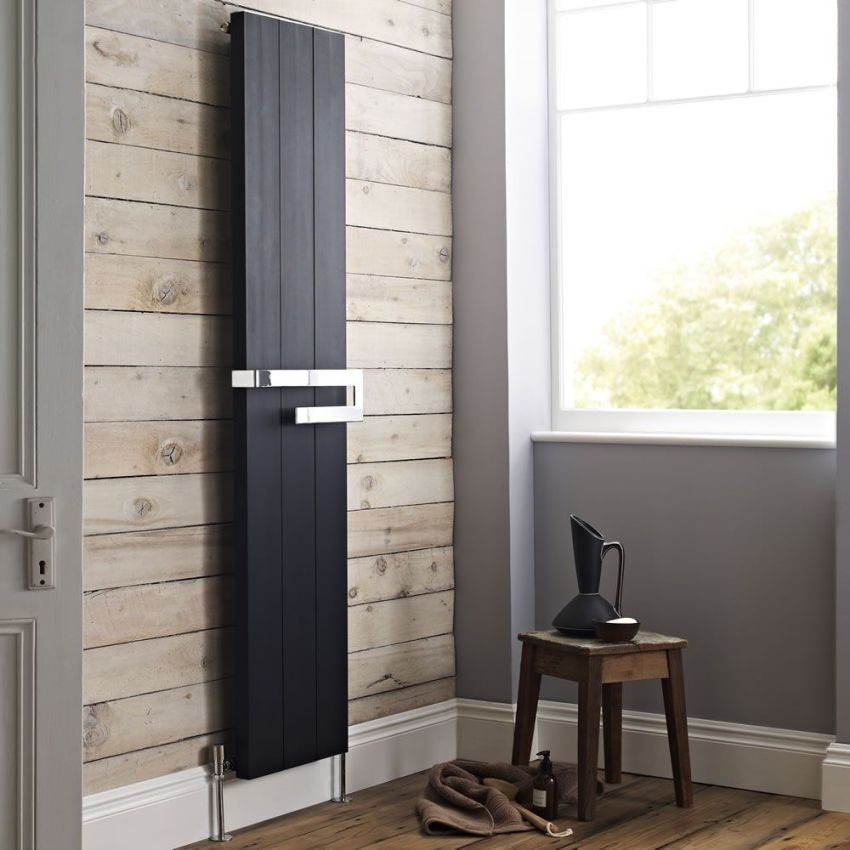
Steel radiators do not tolerate oxygen ingress well; after several summer seasons, even high-quality batteries can rust through and through.
How to calculate the power of radiators and the number of sections?
The radiator must provide a normal temperature regime in the room. To do this, it is necessary to calculate the number of sections before purchasing it. Let's look at some rules to help you perform the appropriate calculation.
First of all, when calculating the power and the number of sections of the heater, it is necessary to focus on its dimensions. It is important to remember that the width of the battery should not be more than 70% of the window opening. To ensure normal heat transfer, the product is installed taking into account the center line of the window. The temperature norm of the heating radiator in the apartment affects the heating of the living space, so you should take the location of the device seriously.
The distance from the working surface (wall) to the heating structure should not be lower than 3 and higher than 5 cm. And it is also worth considering the distance from the floor to the battery. It should not exceed 12 cm. In turn, the recommended distance to the windowsill is 5 cm.
Often, to increase the efficiency of the device, the wall is covered with foil materials. Consider what parameters are required to correctly calculate the radiator power:
- room dimensions;
- number of windows and doors;
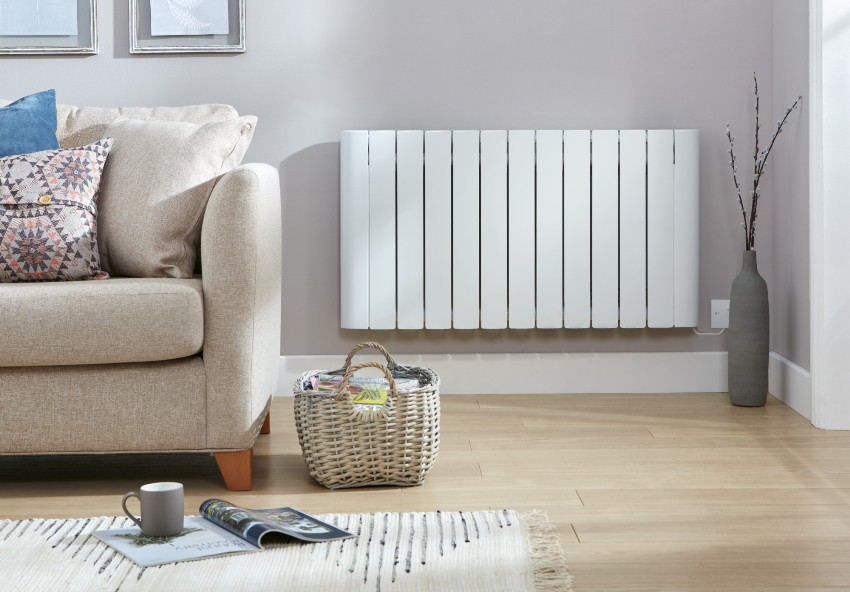
It is rather difficult to calculate the number of heating radiator sections without the help of specialists and additional programs.
- the material from which the building is made;
- location of the apartment.
Among other things, the individual characteristics of the heating circuit must be taken into account.
Heating battery prices from different brands
Today the range of heating equipment is wider than ever. But from many different models, the most popular ones can be distinguished, which differ in adaptability to domestic operational features. An important factor when choosing a heating device is its cost. The price of batteries for heating should correspond to their quality.
Bimetallic devices are rightfully considered the most adapted to domestic conditions. Their cost depends on the company, as well as on the technical parameters. The price of the most popular bimetallic heating device RIFAR MONOLIT 500 is about 5500 rubles. Thus, for 5-6 thousand rubles. you can buy a good battery for your apartment.
Note! The average cost of replacing a heating radiator in an apartment is 2000-3500 rubles. The total amount depends on the type of heating device and its installation features.
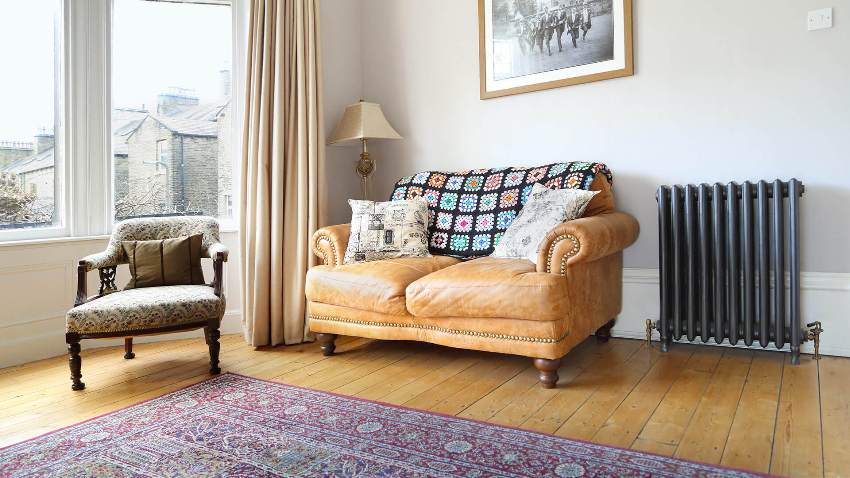
The cost of a radiator should not be a decisive factor for the purchase - an incorrectly selected battery, even a very expensive one, will not last long
Aluminum radiators are less expensive. You can buy a device of this type for only 2500-4500 rubles. In turn, steel and cast iron models are the most expensive. For example, the most popular cast iron battery STI NOVA 500 costs about 7,500 rubles. The price of the most popular steel devices ranges from 6-7 thousand rubles.
To choose a heating device for an apartment, you need to take into account many nuances. But first of all, it is advisable to decide on the financial capabilities and features of the DSP in your home. If necessary, you can seek advice from a specialist who will help you choose an effective device.

